High gas prices hit low-income Americans the hardest
For the highest earners, the pain at the pump is more psychological than anything else. But for lower-income Americans, high gas prices can set off a cycle of hardship.
Driving the news: The daily U.S. average national price for a gallon of regular climbed to $4.99 as of Thursday morning — a cent shy of the symbolic $5 threshold, according to AAA.
The big picture: Those at the top spent the equivalent of about 2% of their income on gas in 2019. That’s the most recent year for which the Bureau of Labor Statistics has survey data that are not skewed by weird pandemic behavior.
- Those at the lower end of the income scale devoted 8% of their after-tax income to gas in 2019. (Although many living in urban areas without cars are spared the expense.)
- In 2008, when gas prices hit a record (inflation-adjusted) high, that group spent close to 12%.
Worth noting: This data looks at gas expenditures as a percentage of income. A more common practice is to slice the numbers as a percentage of overall household spending.
- It looks different that way: The lowest 20% of earners devoted 3.7% of their spending to gas versus 2.7% for the highest earners, per BLS.
- But, we reckon, the income percentages hit home. When you’re living paycheck to paycheck, and you need to drive, your income gets gobbled up.
Meanwhile, more recent data, from Bank of America, shows that Americans who earn less than $50,000 a year are currently spending nearly 10% of their credit card bills on gas, compared with 6% for households earning more than $125,000.
Where it stands: The saving grace now would be that the job market is a lot healthier than it was in 2008. On the other hand, for those who must drive to work, higher gas prices are essentially a pay cut.
- “It can create a cascade of other hardships,” said former Federal Reserve economist Claudia Sahm. If an increased share of your money goes to gas, you have to make painful choices about where that cash comes from.
- This comes at a time of rising food prices, which are also pinching lower-income households.
The bottom line: Gas is “the price that everybody sees,” Sahm said. “I mean people hate this.”
Go Deeper: 5 top ways to save on high gas prices
